Jigsaw puzzles from Japan
The Attic
Deleted puzzles by artist Morita Haruyo
This page shows puzzles that are no longer available, just for historical curiosity, and for completeness.
In some cases puzzles are reissued with a different code number: if you have the old code number from somewhere, this page should show you the replacement (which may still be available).
3000 pieces
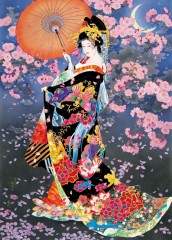 © Haruyo Dark cherry (Haruyo)A courtesan shows off her opulent kimono, among equally luxuriant surroundings—falling cherry blossom, and a crescent moon. Haruyo has added an inscription by her signature: "A smile for you..." The artist Morita Haruyo studied both Japanese art and kimono design, and she combines these with elements of her own Western-influenced technique. (She travelled to London in 1977, exactly the year I [Brian Chandler] first came to Tokyo.) Morita is her family name: she follows the tradition of signing - and sealing - paintings with her given name only.
 Permanently unavailable Permanently unavailableDiscontinued February 2025 An Epoch puzzle: 3000 pieces; 730 x 1020 mm (29" x 40") Code: E21104 (21-104 on package) Retail price ¥4800 |
2542 pieces
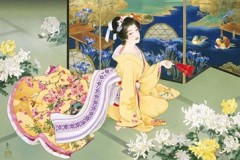 © Haruyo Chrysanthemum banquet (Haruyo)A courtesan waits wistfully, surrounded by the chrysanthemums of the title, with a very lushly painted screen as background. With her ornate kimono patterned with cherry blossoms there are no tedious areas in this puzzle... The artist Morita Haruyo studied both Japanese art and kimono design, and she combines these with elements of her own Western-influenced technique. (She travelled to London in 1977, exactly the year I [Brian Chandler] first came to Tokyo.) Morita is her family name: she follows the tradition of signing - and sealing - paintings with her given name only.
 Permanently unavailable Permanently unavailableDiscontinued October 2019 An Epoch puzzle: 2542 pieces; 750 x 500 mm (30" x 20") Code: E76302 (76-302 on package) Retail price ¥4200 |
2016 pieces
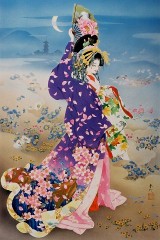 © Studio Morita / Studio Oz Inc Evening mist (Haruyo)A courtesan, with front-tied obi and sumptuous purple kimono, strikes a dramatic pose - her camellia-patterned fan above her head as though to beckon the misty moon. 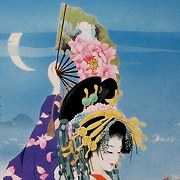 The artist Morita Haruyo studied both Japanese art and kimono design, and she combines these with elements of her own Western-influenced technique. (She travelled to London in 1977, exactly the year I [Brian Chandler] first came to Tokyo.) Morita is her family name: she follows the tradition of signing - and sealing - paintings with her given name only.
 Permanently unavailable Permanently unavailableAn Epoch puzzle: 2016 pieces; 500 x 750 mm (20" x 30") Code: E23301 (23-301 on package) Retail price ¥3600 |
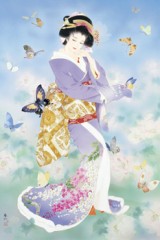 © Studio Morita / Studio Oz Inc Dance of the butterflies (Haruyo)In this simple yet elegant design, the young figure (a geisha?) surrounded by fluttering butterflies seems to muse "Should I be dancing too...?" The artist Morita Haruyo studied both Japanese art and kimono design, and she combines these with elements of her own Western-influenced technique. (She travelled to London in 1977, exactly the year I [Brian Chandler] first came to Tokyo.) Morita is her family name: she follows the tradition of signing - and sealing - paintings with her given name only.
 Permanently unavailable Permanently unavailableAn Epoch puzzle: 2016 pieces; 500 x 750 mm (20" x 30") Code: E23304 (23-304 on package) Retail price ¥3600 |
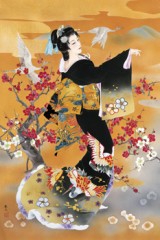 © Haruyo Crane (Haruyo)The crane is a traditional auspicious symbol of happiness and longevity, and here Haruyo combines the cranes decorating the kimono with another pair flying through the sky... This puzzle forms a pair with the Turtle (E23307): you can combine the two for a giant 4000-piece puzzle! The artist Morita Haruyo studied both Japanese art and kimono design, and she combines these with elements of her own Western-influenced technique. (She travelled to London in 1977, exactly the year I [Brian Chandler] first came to Tokyo.) Morita is her family name: she follows the tradition of signing - and sealing - paintings with her given name only.
 Permanently unavailable Permanently unavailableAn Epoch puzzle: 2016 pieces; 500 x 750 mm (20" x 30") Code: E23306 (23-306 on package) Retail price ¥3600 |
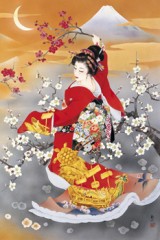 © Haruyo Turtle (Haruyo)The turtle is an ancient symbol of long life and good fortune, often appearing (as here on the kimono) together with a treasure ship. It is said that if a crane lives to be 1000, a turtle lives to be 10,000. This is a picture in Haruyo's lush style, with plenty of background features, from Mount Fuji to the cherry blossom, which will keep the puzzle interesting. This puzzle forms a pair with the Crane (E23306): you can combine the two for a giant 4000-piece puzzle! The artist Morita Haruyo studied both Japanese art and kimono design, and she combines these with elements of her own Western-influenced technique. (She travelled to London in 1977, exactly the year I [Brian Chandler] first came to Tokyo.) Morita is her family name: she follows the tradition of signing - and sealing - paintings with her given name only.
 Permanently unavailable Permanently unavailableAn Epoch puzzle: 2016 pieces; 500 x 750 mm (20" x 30") Code: E23307 (23-307 on package) Retail price ¥3600 |
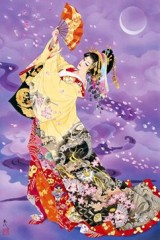 © Haruyo Dragon flower (Haruyo)A classic Haruyo pose of this courtesan(?) in a richly coloured kimono. The outermost layer is decorated with a gorgeous (but as usual ferocious-looking) dragon... The artist Morita Haruyo studied both Japanese art and kimono design, and she combines these with elements of her own Western-influenced technique. (She travelled to London in 1977, exactly the year I [Brian Chandler] first came to Tokyo.) Morita is her family name: she follows the tradition of signing - and sealing - paintings with her given name only.
 Permanently unavailable Permanently unavailableAn Epoch puzzle: 2016 pieces; 500 x 750 mm (20" x 30") Code: E23311 (23-311 on package) Retail price ¥3600 |
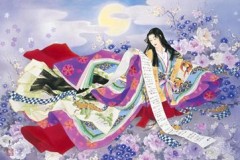 © Haruyo Dream purple (Haruyo)We instantly realise from the ankle-length hair that this character is from the Heian period, a thousand years ago, and an era of cultural flowering and incredibly ornate costumes. She reads a long, long letter, probably in the form of a poem, perhaps from a distant lover. The artist Morita Haruyo studied both Japanese art and kimono design, and she combines these with elements of her own Western-influenced technique. (She travelled to London in 1977, exactly the year I [Brian Chandler] first came to Tokyo.) Morita is her family name: she follows the tradition of signing - and sealing - paintings with her given name only.
 Permanently unavailable Permanently unavailableDiscontinued September 2019 An Epoch puzzle: 2016 pieces; 750 x 500 mm (30" x 20") Code: E23314 (23-314 on package) Retail price ¥3600 |
 © Haruyo Cherry dance (Haruyo)A classic Haruyo figure, in a richly decorated kimono, and surrounded by cherry blossom. The artist Morita Haruyo studied both Japanese art and kimono design, and she combines these with elements of her own Western-influenced technique. (She travelled to London in 1977, exactly the year I [Brian Chandler] first came to Tokyo.) Morita is her family name: she follows the tradition of signing - and sealing - paintings with her given name only.
 Permanently unavailable Permanently unavailableDiscontinued August 2019 An Epoch puzzle: 2016 pieces; 500 x 750 mm (20" x 30") Code: E23319 (23-319 on package) Retail price ¥3600 |
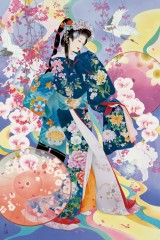 © Haruyo Sheer elegance (Haruyo)The subject is traditional enough, yet Haruyo gives it her distinctive contemporary, flowing touch, for a puzzle filled with interesting colours. The artist Morita Haruyo studied both Japanese art and kimono design, and she combines these with elements of her own Western-influenced technique. (She travelled to London in 1977, exactly the year I [Brian Chandler] first came to Tokyo.) Morita is her family name: she follows the tradition of signing - and sealing - paintings with her given name only.
 Permanently unavailable Permanently unavailableDiscontinued August 2019 An Epoch puzzle: 2016 pieces; 500 x 750 mm (20" x 30") Code: E23323 (23-323 on package) Retail price ¥3600 |
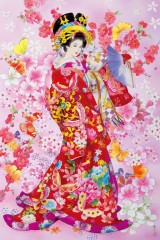 © Epoch Butterfly dream (Haruyo)A typical Haruyo figure has her ornate kimono decorated with butterflies — then many more can be found, almost camouflaged among the flowers. The artist Morita Haruyo studied both Japanese art and kimono design, and she combines these with elements of her own Western-influenced technique. (She travelled to London in 1977, exactly the year I [Brian Chandler] first came to Tokyo.) Morita is her family name: she follows the tradition of signing - and sealing - paintings with her given name only.
 Permanently unavailable Permanently unavailableDiscontinued March 2022 An Epoch puzzle: 2016 pieces; 500 x 750 mm (20" x 30") Code: E23324 (23-324 on package) Retail price ¥3600 |
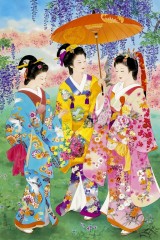 © Haruyo Fragrant flowers (Haruyo)Three classic beauties pose elegantly for us... The artist Morita Haruyo studied both Japanese art and kimono design, and she combines these with elements of her own Western-influenced technique. (She travelled to London in 1977, exactly the year I [Brian Chandler] first came to Tokyo.) Morita is her family name: she follows the tradition of signing - and sealing - paintings with her given name only.
 Permanently unavailable Permanently unavailableDiscontinued March 2023 An Epoch puzzle: 2016 pieces; 500 x 750 mm (20" x 30") Code: E23325 (23-325 on package) Retail price ¥3600 |
 © Haruyo Cherry beauty (Haruyo)A figure in a cherry-blossom kimono stands among a mass of more cherry blossom, in a classic Haruyo portrayal. The artist Morita Haruyo studied both Japanese art and kimono design, and she combines these with elements of her own Western-influenced technique. (She travelled to London in 1977, exactly the year I [Brian Chandler] first came to Tokyo.) Morita is her family name: she follows the tradition of signing - and sealing - paintings with her given name only.
 Permanently unavailable Permanently unavailableDiscontinued June 2024 An Epoch puzzle: 2016 pieces; 500 x 750 mm (20" x 30") Code: E23326 (23-326 on package) Retail price ¥3600 |
2000 pieces
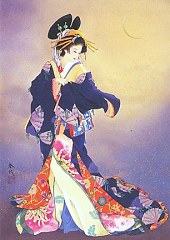 © Studio Morita / Studio Oz Inc Moonlight (Haruyo)Another sumptuously clad, but demure beauty - Haruyo has lost no opportunity to show us as many layers as possible. Original title: Tsukiakari  The artist Morita Haruyo studied both Japanese art and kimono design, and she combines these with elements of her own Western-influenced technique. (She travelled to London in 1977, exactly the year I [Brian Chandler] first came to Tokyo.) Morita is her family name: she follows the tradition of signing - and sealing - paintings with her given name only.  Permanently unavailable Permanently unavailableAn Epoch puzzle: 2000 pieces; 730 x 1020 mm (29" x 40") Code: E20104 (20-104 on package) Retail price ¥4800 |
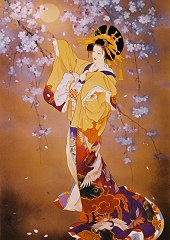 © Studio Morita / Studio Oz Inc Evening (Haruyo)The wearer of this luxurious kimono - with a crane motif - has the obi (sash) tied at the front, a sign that she is a courtesan. Under thin moonlight filtering through the cherry blossoms, she has playfully wrapped the long sleeves around her hands. Original title: Yoi 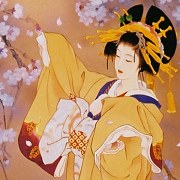 The artist Morita Haruyo studied both Japanese art and kimono design, and she combines these with elements of her own Western-influenced technique. (She travelled to London in 1977, exactly the year I [Brian Chandler] first came to Tokyo.) Morita is her family name: she follows the tradition of signing - and sealing - paintings with her given name only.  Permanently unavailable Permanently unavailableAn Epoch puzzle: 2000 pieces; 730 x 1020 mm (29" x 40") Code: E20109 (20-109 on package) Retail price ¥4800 |
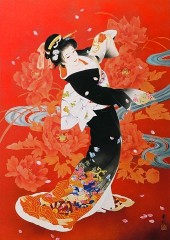 © Studio Morita / Studio Oz Inc Scarlet (Haruyo)A classic geisha pose - the model playfully shows off the ornate furisode sleeves of her kimono, against the background of a sumptuous red peony design. The original title, hien, is a rather fanciful word that might be translated "voluptuous scarlet." 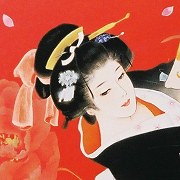 The artist Morita Haruyo studied both Japanese art and kimono design, and she combines these with elements of her own Western-influenced technique. (She travelled to London in 1977, exactly the year I [Brian Chandler] first came to Tokyo.) Morita is her family name: she follows the tradition of signing - and sealing - paintings with her given name only.  Permanently unavailable Permanently unavailableAn Epoch puzzle: 2000 pieces; 730 x 1020 mm (29" x 40") Code: E20113 (20-113 on package) Retail price ¥4800 |
1900 pieces
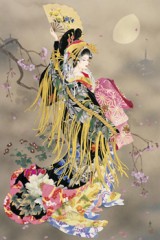 © Haruyo Song of the moon (Haruyo)A classic Haruyo pose, of a dancer with a ceremonial rope (Shimenawa). The kimono layers show a brilliant range of colour, while the background is subdued yet not plain, for there is cherry blossom, daisies, and a distant pagoda. The artist Morita Haruyo studied both Japanese art and kimono design, and she combines these with elements of her own Western-influenced technique. (She travelled to London in 1977, exactly the year I [Brian Chandler] first came to Tokyo.) Morita is her family name: she follows the tradition of signing - and sealing - paintings with her given name only.
 Permanently unavailable Permanently unavailableAn Epoch puzzle: 1900 pieces; 500 x 750 mm (20" x 30") Code: E17103 (17-103 on package) Retail price ¥3900 |
1518 pieces
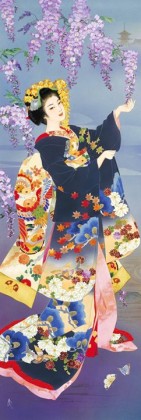 © Haruyo Wisteria beauty (Haruyo)Against a subdued background, Haruyo portrays a figure in a luxuriant kimono decorated with flower and bird motifs in rich colours. The wisteria of the title hangs over her — the plant is native to Japan, and is called fuji (no particular connection with the mountain name). This puzzle can be combined with the Lily puzzle (code E18018) to make a 3000+ piece panel. The artist Morita Haruyo studied both Japanese art and kimono design, and she combines these with elements of her own Western-influenced technique. (She travelled to London in 1977, exactly the year I [Brian Chandler] first came to Tokyo.) Morita is her family name: she follows the tradition of signing - and sealing - paintings with her given name only.
 Permanently unavailable Permanently unavailableAn Epoch puzzle: 1518 pieces; 340 x 1020 mm (13" x 40") Code: E18017 (18-017 on package) Retail price ¥3000 |
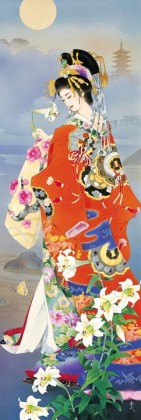 © Haruyo Lily beauty (Haruyo)Against a subdued background, Haruyo portrays a figure in a floral patterned kimono in rich colours. The model holds a single lily bloom, but there are more at her feet. These lilies are common in Japan, and are called yuri. This puzzle can be combined with the Wisteria puzzle (code E18017) to make a 3000+ piece panel. The artist Morita Haruyo studied both Japanese art and kimono design, and she combines these with elements of her own Western-influenced technique. (She travelled to London in 1977, exactly the year I [Brian Chandler] first came to Tokyo.) Morita is her family name: she follows the tradition of signing - and sealing - paintings with her given name only.
 Permanently unavailable Permanently unavailableDiscontinued June 2018 An Epoch puzzle: 1518 pieces; 340 x 1020 mm (13" x 40") Code: E18018 (18-018 on package) Retail price ¥3000 |
1500 pieces
 © Studio Morita / Studio Oz Inc Spirit of the heron (Haruyo)This dance is a classic kabuki number, entitled sagi-musume or the Heron-girl, in which the single dancer portrays the agony of love, through all its phases. By folding or unfolding parts of her costume, she can completely change her appearance. This is another chance for Haruyo to show us richly varied kimono layers, which she has set against a luxuriant purple backdrop. 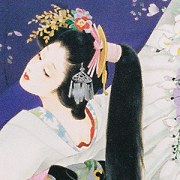 The artist Morita Haruyo studied both Japanese art and kimono design, and she combines these with elements of her own Western-influenced technique. (She travelled to London in 1977, exactly the year I [Brian Chandler] first came to Tokyo.) Morita is her family name: she follows the tradition of signing - and sealing - paintings with her given name only.
 Permanently unavailable Permanently unavailableAn Epoch puzzle: 1500 pieces; 500 x 750 mm (20" x 30") Code: E15029 (15-029 on package) Retail price ¥3000 |
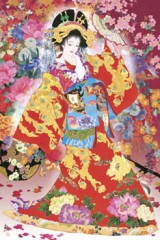 © Studio Morita / Studio Oz Inc Agemaki (Haruyo)Agemaki is the courtesan in the classic kabuki play Sukeroku yukari no Edo zakura, a story of her suicide pact with her lover Sukeroku. Here Haruyo portrays her in gorgeous pose on her ornate multi-layered kimono. The artist Morita Haruyo studied both Japanese art and kimono design, and she combines these with elements of her own Western-influenced technique. (She travelled to London in 1977, exactly the year I [Brian Chandler] first came to Tokyo.) Morita is her family name: she follows the tradition of signing - and sealing - paintings with her given name only.
 Permanently unavailable Permanently unavailableAn Epoch puzzle: 1500 pieces; 500 x 750 mm (20" x 30") Code: E15032 (15-032 on package) Retail price ¥3000 |
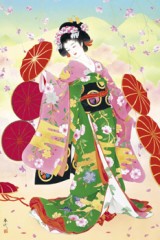 © Studio Morita / Studio Oz Inc Hanako (from Musume Dojoji) (Haruyo)Hanako is the principal character of this, the Kabuki version of the Dojoji story. Here Haruyo shows a dance early in the story (before she begins to turn into a snake!) where her accessories are brightly coloured sunshades. These are not umbrellas in form, rather the type of wide headgear used for sun protection and tied under the chin. The artist Morita Haruyo studied both Japanese art and kimono design, and she combines these with elements of her own Western-influenced technique. (She travelled to London in 1977, exactly the year I [Brian Chandler] first came to Tokyo.) Morita is her family name: she follows the tradition of signing - and sealing - paintings with her given name only.
 Permanently unavailable Permanently unavailableAn Epoch puzzle: 1500 pieces; 500 x 750 mm (20" x 30") Code: E15042 (15-042 on package) Retail price ¥3000 |
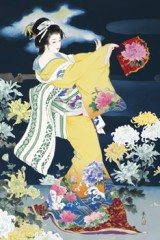 © Studio Morita / Studio Oz Inc Suiga (Haruyo)A geisha dances a scene from the classic kabuki play of old Tokyo O-matsuri ("festival", referring to one of the three great Tokyo festivals). The title, Suiga is perhaps a fanciful name for the dancer, evoking grace and purity... The artist Morita Haruyo studied both Japanese art and kimono design, and she combines these with elements of her own Western-influenced technique. (She travelled to London in 1977, exactly the year I [Brian Chandler] first came to Tokyo.) Morita is her family name: she follows the tradition of signing - and sealing - paintings with her given name only.
 Permanently unavailable Permanently unavailableAn Epoch puzzle: 1500 pieces; 500 x 750 mm (20" x 30") Code: E15049 (15-049 on package) Retail price ¥3000 |
1053 pieces
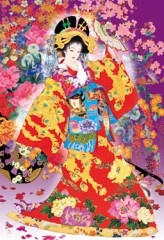 © Studio Morita / Studio Oz Inc Agemaki (Haruyo)Agemaki is the courtesan in the classic kabuki play Sukeroku yukari no Edo zakura, a story of her suicide pact with her lover Sukeroku. Here Haruyo portrays her in gorgeous pose on her ornate multi-layered kimono. The artist Morita Haruyo studied both Japanese art and kimono design, and she combines these with elements of her own Western-influenced technique. (She travelled to London in 1977, exactly the year I [Brian Chandler] first came to Tokyo.) Morita is her family name: she follows the tradition of signing - and sealing - paintings with her given name only.
 Permanently unavailable Permanently unavailableDiscontinued March 2018 An Apollo puzzle: 1053 pieces; 260 x 380 mm (10" x 15") Code: P49703 (49-703 on package) Retail price ¥2300 |
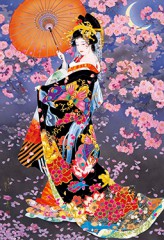 © Haruyo Dark cherry (Haruyo)A courtesan shows off her opulent kimono, among equally luxuriant surroundings—falling cherry blossom, and a crescent moon. Haruyo has added an inscription by her signature: "A smile for you..." The artist Morita Haruyo studied both Japanese art and kimono design, and she combines these with elements of her own Western-influenced technique. (She travelled to London in 1977, exactly the year I [Brian Chandler] first came to Tokyo.) Morita is her family name: she follows the tradition of signing - and sealing - paintings with her given name only.
 Permanently unavailable Permanently unavailableDiscontinued December 2017 An Apollo puzzle: 1053 pieces; 260 x 380 mm (10" x 15") Code: P49712 (49-712 on package) Retail price ¥2300 |
1014 pieces
 © Studio Morita / Studio Oz Inc Evening mist (Haruyo)A courtesan, with front-tied obi and sumptuous purple kimono, strikes a dramatic pose - her camellia-patterned fan above her head as though to beckon the misty moon. 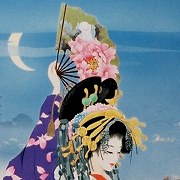 The artist Morita Haruyo studied both Japanese art and kimono design, and she combines these with elements of her own Western-influenced technique. (She travelled to London in 1977, exactly the year I [Brian Chandler] first came to Tokyo.) Morita is her family name: she follows the tradition of signing - and sealing - paintings with her given name only.
 Permanently unavailable Permanently unavailableAn Epoch puzzle: 1014 pieces; 380 x 530 mm (15" x 21") Code: E56005 (56-005 on package) Retail price ¥2000 |
1000 pieces
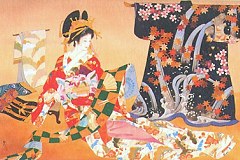 © Studio Morita / Studio Oz Inc Adesugata (Haruyo)I first translated the title, Adesugata, as "allure" - feeling I ought to be polite, but a bit puzzled since this actually means something like "sexy pose". I really couldn't see why, until it was pointed out to me that the figure is a courtesan (since she has the bow tied at the front), and moreover she is besporting herself in her undies! The black kimono hanging in the background is her overgarment, and we are seeing the next layer down. (I think it's just Haruyo's excuse to paint more kimonos...) Note that this puzzle also appears on the back of some boxes, but with an older product code: 1000-609. 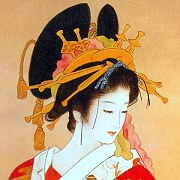 The artist Morita Haruyo studied both Japanese art and kimono design, and she combines these with elements of her own Western-influenced technique. (She travelled to London in 1977, exactly the year I [Brian Chandler] first came to Tokyo.) Morita is her family name: she follows the tradition of signing - and sealing - paintings with her given name only.  Permanently unavailable Permanently unavailableAn Epoch puzzle: 1000 pieces; 750 x 500 mm (30" x 20") Code: E11012 (11-012 on package) Retail price ¥3000 | ||
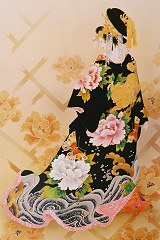 © Studio Morita / Studio Oz Inc Shishinomai (Haruyo)The "Lion dance" - strictly though, this kimono is decorated with a Shishi, the mythical beast that reached Japan from China and Korea.  More about the shishi in Mark Schumacher's Buddhist Corner The artist Morita Haruyo studied both Japanese art and kimono design, and she combines these with elements of her own Western-influenced technique. (She travelled to London in 1977, exactly the year I [Brian Chandler] first came to Tokyo.) Morita is her family name: she follows the tradition of signing - and sealing - paintings with her given name only.  Permanently unavailable Permanently unavailableAn Epoch puzzle: 1000 pieces; 500 x 750 mm (20" x 30") Code: E11013 (11-013 on package) Retail price ¥3000 | ||
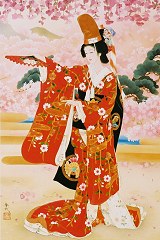 © Studio Morita / Studio Oz Inc Dôjôji (Haruyo)This is a portrayal of the dancing girl of Dôjôji, a temple in Western Japan. This very traditional story has origins in Noh theatre, but also exists in a more recent Kabuki version. In a nutshell, she captivates the priests with her dancing. We see Haruyo's character dancing with a fan, though her expression (and the ornate costume) suggests the dance is rather sedate. The background is reminiscent of traditional Japanese theatre scenery, with its highly stylised pine trees and cherry blossoms. 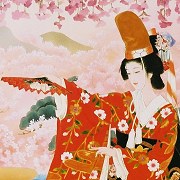 Synopsis of the kabuki version - for more sites, try Google, and search for "Musume Dojoji". The artist Morita Haruyo studied both Japanese art and kimono design, and she combines these with elements of her own Western-influenced technique. (She travelled to London in 1977, exactly the year I [Brian Chandler] first came to Tokyo.) Morita is her family name: she follows the tradition of signing - and sealing - paintings with her given name only.  Permanently unavailable Permanently unavailableAn Epoch puzzle: 1000 pieces; 500 x 750 mm (20" x 30") Code: E11035 (11-035 on package) Retail price ¥3000 | ||
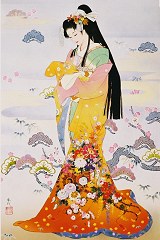 © Studio Morita / Studio Oz Inc Floral (Haruyo)A somewhat pensive lady displays this sumptuously florid kimono. The background gives a semi-abstract impression of clouds and plants, simultaneously reflecting the artist's enthusiasm for textile design. Original title: Shôka ("Syoka" on the box)  The artist Morita Haruyo studied both Japanese art and kimono design, and she combines these with elements of her own Western-influenced technique. (She travelled to London in 1977, exactly the year I [Brian Chandler] first came to Tokyo.) Morita is her family name: she follows the tradition of signing - and sealing - paintings with her given name only.  Permanently unavailable Permanently unavailableAn Epoch puzzle: 1000 pieces; 500 x 750 mm (20" x 30") Code: E11041 (11-041 on package) Retail price ¥3000 | ||
 © Studio Morita / Studio Oz Inc Two ladies (Haruyo)The original title, Futarimai, literally means "a dance of two people" and the two figures are posed as if in a swirl of fallen cherry blossom. Remember (see detail below) that traditionally the feature of a kimono regarded as sexiest was the revealed back of the neck. 
The artist Morita Haruyo studied both Japanese art and kimono design, and she combines these with elements of her own Western-influenced technique. (She travelled to London in 1977, exactly the year I [Brian Chandler] first came to Tokyo.) Morita is her family name: she follows the tradition of signing - and sealing - paintings with her given name only.  Permanently unavailable Permanently unavailableAn Epoch puzzle: 1000 pieces; 500 x 750 mm (20" x 30") Code: E11053 (11-053 on package) Retail price ¥3000 | ||
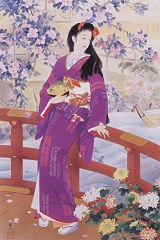 © Studio Morita / Studio Oz Inc Lovelorn (Haruyo)The young beauty looks wistfully from the bridge - Haruyo sets her off against a background of camellias and the clump of chrysanthemums in the foreground. 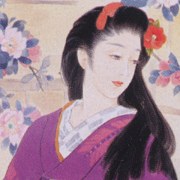 The artist Morita Haruyo studied both Japanese art and kimono design, and she combines these with elements of her own Western-influenced technique. (She travelled to London in 1977, exactly the year I [Brian Chandler] first came to Tokyo.) Morita is her family name: she follows the tradition of signing - and sealing - paintings with her given name only.  Permanently unavailable Permanently unavailableAn Epoch puzzle: 1000 pieces; 500 x 750 mm (20" x 30") Code: E11064 (11-064 on package) Retail price ¥3000 | ||
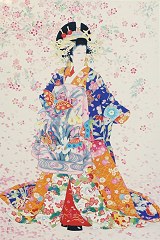 © Studio Morita / Studio Oz Inc Flower thoughts (Haruyo)"Flower thoughts" indeed! Haruyo has gone almost over the top here: the subject has an almost quizzical expression, as if to say "Me? Overdressed?" In addition to her elaborate obi and headwear, petals from the cherry tree flutter down all over her, leaving absolutely no blank areas in this puzzle! Original title: Kasou 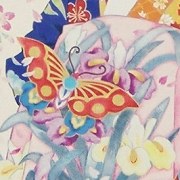 The artist Morita Haruyo studied both Japanese art and kimono design, and she combines these with elements of her own Western-influenced technique. (She travelled to London in 1977, exactly the year I [Brian Chandler] first came to Tokyo.) Morita is her family name: she follows the tradition of signing - and sealing - paintings with her given name only.  Permanently unavailable Permanently unavailableAn Epoch puzzle: 1000 pieces; 500 x 750 mm (20" x 30") Code: E11071 (11-071 on package) Retail price ¥3000 | ||
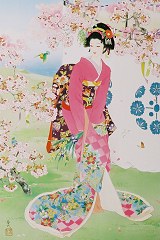 © Studio Morita / Studio Oz Inc
Haruka (Haruyo)Spring! The youthful Haruka, in her bright pink kimono, holds a spray of forsythia and irises. Perhaps the drape in the background is ready for some celebrations under the cherry blossoms? 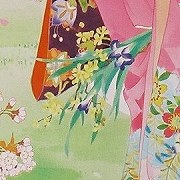 The artist Morita Haruyo studied both Japanese art and kimono design, and she combines these with elements of her own Western-influenced technique. (She travelled to London in 1977, exactly the year I [Brian Chandler] first came to Tokyo.) Morita is her family name: she follows the tradition of signing - and sealing - paintings with her given name only.  Permanently unavailable Permanently unavailableAn Epoch puzzle: 1000 pieces; 500 x 750 mm (20" x 30") Code: E11083 (11-083 on package) Retail price ¥3000 | ||
 © Studio Morita / Studio Oz Inc Evening (Haruyo)The wearer of this luxurious kimono - with a crane motif - has the obi (sash) tied at the front, a sign that she is a courtesan. Under thin moonlight filtering through the cherry blossoms, she has playfully wrapped the long sleeves around her hands. Original title: Yoi 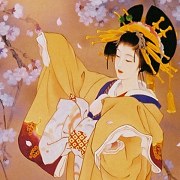 The artist Morita Haruyo studied both Japanese art and kimono design, and she combines these with elements of her own Western-influenced technique. (She travelled to London in 1977, exactly the year I [Brian Chandler] first came to Tokyo.) Morita is her family name: she follows the tradition of signing - and sealing - paintings with her given name only.  Permanently unavailable Permanently unavailableAn Epoch puzzle: 1000 pieces; 500 x 750 mm (20" x 30") Code: E11087 (11-087 on package) Retail price ¥3000 | ||
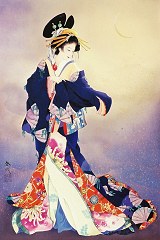 © Studio Morita / Studio Oz Inc Moonlight (Haruyo)Another sumptuously clad, but demure beauty - Haruyo has lost no opportunity to show us as many layers as possible. Original title: Tsukiakari  The artist Morita Haruyo studied both Japanese art and kimono design, and she combines these with elements of her own Western-influenced technique. (She travelled to London in 1977, exactly the year I [Brian Chandler] first came to Tokyo.) Morita is her family name: she follows the tradition of signing - and sealing - paintings with her given name only.  Permanently unavailable Permanently unavailableAn Epoch puzzle: 1000 pieces; 500 x 750 mm (20" x 30") Code: E11088 (11-088 on package) Retail price ¥3000 | ||
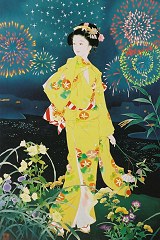 © Studio Morita / Studio Oz Inc
Ayaka (Haruyo)Midsummer night! To a background of fireworks, the young Ayaka stands among summer flowers. 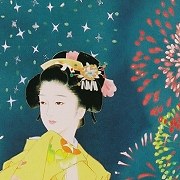 The artist Morita Haruyo studied both Japanese art and kimono design, and she combines these with elements of her own Western-influenced technique. (She travelled to London in 1977, exactly the year I [Brian Chandler] first came to Tokyo.) Morita is her family name: she follows the tradition of signing - and sealing - paintings with her given name only.  Permanently unavailable Permanently unavailableAn Epoch puzzle: 1000 pieces; 500 x 750 mm (20" x 30") Code: E11092 (11-092 on package) Retail price ¥3000 | ||
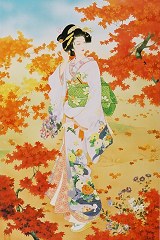 © Studio Morita / Studio Oz Inc
Chiaki (Haruyo)A thousand autumns! Chiaki has a slightly quizzical look as she stands gracefully in her kimono, surrounded by brilliant red maples.  The artist Morita Haruyo studied both Japanese art and kimono design, and she combines these with elements of her own Western-influenced technique. (She travelled to London in 1977, exactly the year I [Brian Chandler] first came to Tokyo.) Morita is her family name: she follows the tradition of signing - and sealing - paintings with her given name only.  Permanently unavailable Permanently unavailableAn Epoch puzzle: 1000 pieces; 500 x 750 mm (20" x 30") Code: E11096 (11-096 on package) Retail price ¥3000 | ||
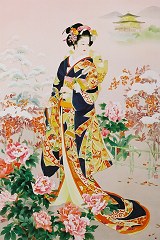 © Studio Morita / Studio Oz Inc
Fuyune (Haruyo)Winter! Fuyune holds her new year's "arrow of good fortune", surrounded by peonies, pine and red-berried nanten bushes weighed down by snow dumplings. Haruyo has thoughtfully added a distant golden pavilion (Kinkakuji) to break up what would otherwise be a large blank area in the upper right corner. 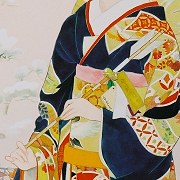 The artist Morita Haruyo studied both Japanese art and kimono design, and she combines these with elements of her own Western-influenced technique. (She travelled to London in 1977, exactly the year I [Brian Chandler] first came to Tokyo.) Morita is her family name: she follows the tradition of signing - and sealing - paintings with her given name only.  Permanently unavailable Permanently unavailableAn Epoch puzzle: 1000 pieces; 500 x 750 mm (20" x 30") Code: E11098 (11-098 on package) Retail price ¥3000 | ||
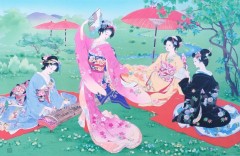 © Studio Morita / Studio Oz Inc The garden of the four seasons (Haruyo)Here we see the four ladies, representing the seasons, gathered together in a lawn party somehow reminiscent of a scene from the French impressionists. One dances with a fan, another accompanying her on the koto; a third reads, while the fourth is content to watch. 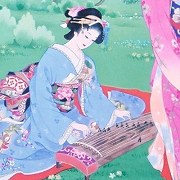 The artist Morita Haruyo studied both Japanese art and kimono design, and she combines these with elements of her own Western-influenced technique. (She travelled to London in 1977, exactly the year I [Brian Chandler] first came to Tokyo.) Morita is her family name: she follows the tradition of signing - and sealing - paintings with her given name only.  Permanently unavailable Permanently unavailableAn Epoch puzzle: 1000 pieces; 750 x 500 mm (30" x 20") Code: E11121 (11-121 on package) Retail price ¥3000 | ||
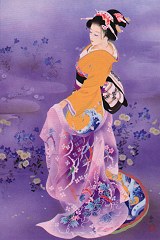 © Studio Morita / Studio Oz Inc Violet (Haruyo)A delicate young model holds a gauzy purple veil, and just reveals on her sleeve an echo of Hokusai's "Wave." Original title: Shiyu 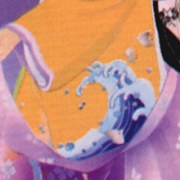 The artist Morita Haruyo studied both Japanese art and kimono design, and she combines these with elements of her own Western-influenced technique. (She travelled to London in 1977, exactly the year I [Brian Chandler] first came to Tokyo.) Morita is her family name: she follows the tradition of signing - and sealing - paintings with her given name only.  Permanently unavailable Permanently unavailableAn Epoch puzzle: 1000 pieces; 500 x 750 mm (20" x 30") Code: E11128 (11-128 on package) Retail price ¥3000 | ||
 © Studio Morita / Studio Oz Inc Cherry (Haruyo)A young girl, her kimono decorated with delicate pink origami cranes, shelters under her diaphanous umbrella - the wind gusts a shower of cherry blossom petals. Haruyo has completed the scene with Mt. Fuji in the distance. Original title: Yumezakura, literally "dream cherry" 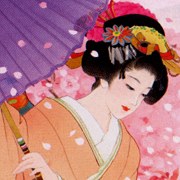 The artist Morita Haruyo studied both Japanese art and kimono design, and she combines these with elements of her own Western-influenced technique. (She travelled to London in 1977, exactly the year I [Brian Chandler] first came to Tokyo.) Morita is her family name: she follows the tradition of signing - and sealing - paintings with her given name only.  Permanently unavailable Permanently unavailableAn Epoch puzzle: 1000 pieces; 500 x 750 mm (20" x 30") Code: E11147 (11-147 on package) Retail price ¥3000 | ||
 © Studio Morita / Studio Oz Inc Verdant (Haruyo)The wearer of this palest of green kimonos looks wistful. (Why does she bite her veil, I wonder?) The original title Ryokufû does not translate easily: literally it is "green wind", but "summer breezes" might be closer to the image Haruyo is evoking. 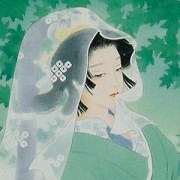 The artist Morita Haruyo studied both Japanese art and kimono design, and she combines these with elements of her own Western-influenced technique. (She travelled to London in 1977, exactly the year I [Brian Chandler] first came to Tokyo.) Morita is her family name: she follows the tradition of signing - and sealing - paintings with her given name only.  Permanently unavailable Permanently unavailableAn Epoch puzzle: 1000 pieces; 500 x 750 mm (20" x 30") Code: E11151 (11-151 on package) Retail price ¥3000 | ||
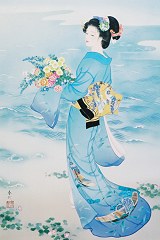 © Studio Morita / Studio Oz Inc Azure (Haruyo)With the sea as backdrop, the model holds a posy of assorted summer flowers, while her elegant but simple kimono is set off perfectly by the obi decorated with a pair of crested ibises. (Though the birds have a somewhat unusual bluish tinge.) Original title: Seisui ("blue purity") 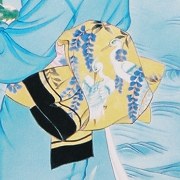 The artist Morita Haruyo studied both Japanese art and kimono design, and she combines these with elements of her own Western-influenced technique. (She travelled to London in 1977, exactly the year I [Brian Chandler] first came to Tokyo.) Morita is her family name: she follows the tradition of signing - and sealing - paintings with her given name only.  Permanently unavailable Permanently unavailableAn Epoch puzzle: 1000 pieces; 500 x 750 mm (20" x 30") Code: E11152 (11-152 on package) Retail price ¥3000 | ||
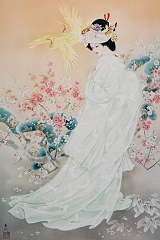 © Studio Morita / Studio Oz Inc Lustrous white (Haruyo)This young bride has a modest enough pose, but her wedding kimono is luxuriant - diaphanous, a tinge of pale green, with a pattern of white cranes. Over the plum blossoms in the background, a pair of golden cranes bring good fortune. Original title: Kihaku 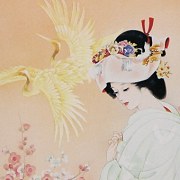 The artist Morita Haruyo studied both Japanese art and kimono design, and she combines these with elements of her own Western-influenced technique. (She travelled to London in 1977, exactly the year I [Brian Chandler] first came to Tokyo.) Morita is her family name: she follows the tradition of signing - and sealing - paintings with her given name only.  Permanently unavailable Permanently unavailableAn Epoch puzzle: 1000 pieces; 500 x 750 mm (20" x 30") Code: E11164 (11-164 on package) Retail price ¥3000 | ||
 © Studio Morita / Studio Oz Inc Scarlet (Haruyo)A classic geisha pose - the model playfully shows off the ornate furisode sleeves of her kimono, against the background of a sumptuous red peony design. The original title, hien, is a rather fanciful word that might be translated "voluptuous scarlet." 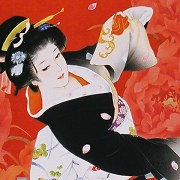 The artist Morita Haruyo studied both Japanese art and kimono design, and she combines these with elements of her own Western-influenced technique. (She travelled to London in 1977, exactly the year I [Brian Chandler] first came to Tokyo.) Morita is her family name: she follows the tradition of signing - and sealing - paintings with her given name only.  Permanently unavailable Permanently unavailableAn Epoch puzzle: 1000 pieces; 500 x 750 mm (20" x 30") Code: E11173 (11-173 on package) Retail price ¥3000 | ||
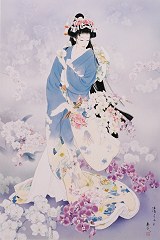 © Studio Morita / Studio Oz Inc Orchid (Haruyo)More precisely Phalaenopsis or the moth orchid - the young lady in this picture is surrounded by these exquisite and exotic blooms. It is difficult for the Web version to do justice to the delicate beauty of this image. The original title, Kochouran is literally "moth orchid". (Incidentally, these are said to be relatively easy orchids to grow yourself!) 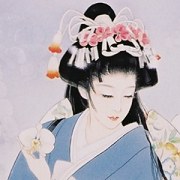 The artist Morita Haruyo studied both Japanese art and kimono design, and she combines these with elements of her own Western-influenced technique. (She travelled to London in 1977, exactly the year I [Brian Chandler] first came to Tokyo.) Morita is her family name: she follows the tradition of signing - and sealing - paintings with her given name only.  Permanently unavailable Permanently unavailableAn Epoch puzzle: 1000 pieces; 500 x 750 mm (20" x 30") Code: E11174 (11-174 on package) Retail price ¥3000 | ||
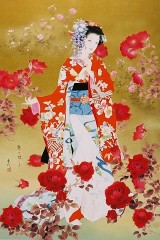 © Studio Morita / Studio Oz Inc Rose (Haruyo)The rose - symbol of love and pain; Haruyo has drawn this beguiling figure surrounded by red roses, and has written a subtitle by her signature. Atsuki-omoi-wo - "with passion"... 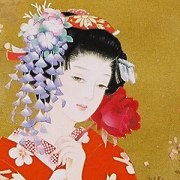 The artist Morita Haruyo studied both Japanese art and kimono design, and she combines these with elements of her own Western-influenced technique. (She travelled to London in 1977, exactly the year I [Brian Chandler] first came to Tokyo.) Morita is her family name: she follows the tradition of signing - and sealing - paintings with her given name only.  Permanently unavailable Permanently unavailableAn Epoch puzzle: 1000 pieces; 500 x 750 mm (20" x 30") Code: E11180 (11-180 on package) Retail price ¥3000 | ||
 © Studio Morita / Studio Oz Inc Chrysanthemum (Haruyo)By her signature and seal, Haruyo has written "With noble heart..." - a fitting phrase, remembering that the chrysanthemum is the symbol of the Japanese Imperial crown. The courtesan wears a kimono of deep blue and gold, with an obi of purple, decorated with peacock feathers. 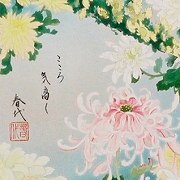 The artist Morita Haruyo studied both Japanese art and kimono design, and she combines these with elements of her own Western-influenced technique. (She travelled to London in 1977, exactly the year I [Brian Chandler] first came to Tokyo.) Morita is her family name: she follows the tradition of signing - and sealing - paintings with her given name only.  Permanently unavailable Permanently unavailableAn Epoch puzzle: 1000 pieces; 500 x 750 mm (20" x 30") Code: E11181 (11-181 on package) Retail price ¥3000 | ||
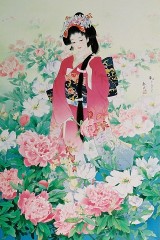 © Studio Morita / Studio Oz Inc Peony (Haruyo)Holding a peony in her hand, the young figure in this picture (the hairstyle shows her to be a princess) is surrounded by a veritable forest of blooms. Haruyo stresses the innocence of her pose with the subtitle "Shyly..." (by the signature). 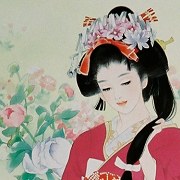 The artist Morita Haruyo studied both Japanese art and kimono design, and she combines these with elements of her own Western-influenced technique. (She travelled to London in 1977, exactly the year I [Brian Chandler] first came to Tokyo.) Morita is her family name: she follows the tradition of signing - and sealing - paintings with her given name only.  Permanently unavailable Permanently unavailableAn Epoch puzzle: 1000 pieces; 500 x 750 mm (20" x 30") Code: E11190 (11-190 on package) Retail price ¥3000 | ||
 © Studio Morita / Studio Oz Inc Iris (Haruyo)The figure standing amidst this luxuriant bed of irises wears a rich red kimono with the black hem that marks her as a daughter of the merchant class. Haruyo has again added an inscription by her signature - "Treasuring you..."  The artist Morita Haruyo studied both Japanese art and kimono design, and she combines these with elements of her own Western-influenced technique. (She travelled to London in 1977, exactly the year I [Brian Chandler] first came to Tokyo.) Morita is her family name: she follows the tradition of signing - and sealing - paintings with her given name only.  Permanently unavailable Permanently unavailableAn Epoch puzzle: 1000 pieces; 500 x 750 mm (20" x 30") Code: E11195 (11-195 on package) Retail price ¥3000 | ||
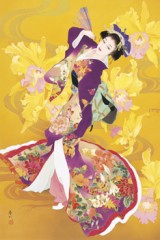 © Studio Morita / Studio Oz Inc Yellow splendour (Haruyo)The original title, Ouka, combines the charcter for "yellow" with that for "lustrous", in a way it is difficult to capture in English! The subject wears a kimono richly patterned in reds and purple, and stands on a background of fanciful flowers, in a setting of the richest deepest yellow... The artist Morita Haruyo studied both Japanese art and kimono design, and she combines these with elements of her own Western-influenced technique. (She travelled to London in 1977, exactly the year I [Brian Chandler] first came to Tokyo.) Morita is her family name: she follows the tradition of signing - and sealing - paintings with her given name only.
 Permanently unavailable Permanently unavailableAn Epoch puzzle: 1000 pieces; 500 x 750 mm (20" x 30") Code: E11307 (11-307 on package) Retail price ¥3000 | ||
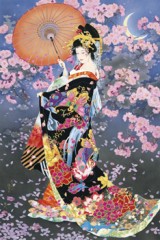 © Studio Morita / Studio Oz Inc Dark cherry (Haruyo)A courtesan shows off her opulent kimono, among equally luxuriant surroundings—falling cherry blossom, and a crescent moon. Haruyo has added an inscription by her signature: "A smile for you..." The artist Morita Haruyo studied both Japanese art and kimono design, and she combines these with elements of her own Western-influenced technique. (She travelled to London in 1977, exactly the year I [Brian Chandler] first came to Tokyo.) Morita is her family name: she follows the tradition of signing - and sealing - paintings with her given name only.
 Permanently unavailable Permanently unavailableDiscontinued November 2019 An Epoch puzzle: 1000 pieces; 500 x 750 mm (20" x 30") Code: E11322 (11-322 on package) Retail price ¥3000 | ||
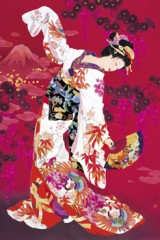 © Studio Morita / Studio Oz Inc Dance of celebration (Haruyo)There are many famous traditional Japanese dances of celebration, which Haruyo represents figuratively here. The dancer adopts a striking pose, with fan held low, to show off her flamboyant kimono. This is decorated with cranes and red bamboo, auspicious emblems to set off the rich red background Mount Fuji... The artist Morita Haruyo studied both Japanese art and kimono design, and she combines these with elements of her own Western-influenced technique. (She travelled to London in 1977, exactly the year I [Brian Chandler] first came to Tokyo.) Morita is her family name: she follows the tradition of signing - and sealing - paintings with her given name only.  Permanently unavailable Permanently unavailableAn Epoch puzzle: 1000 pieces; 500 x 750 mm (20" x 30") Code: E11329 (11-329 on package) Retail price ¥3000 | ||
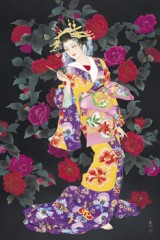 © Haruyo Charcoal (Haruyo)Haruyo has succeeded with a difficult artistic challenge—to make "black" into an alluring theme. This courtesan wears a kimono of vivid orange and purple, well set off against the black background with its lacework of red peonies. In her right hand she holds a kiseru, the traditional style of tobacco pipe, and her bare right foot peeps enticingly from the hem of her kimono. 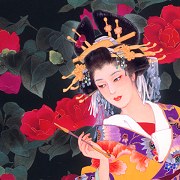 The artist Morita Haruyo studied both Japanese art and kimono design, and she combines these with elements of her own Western-influenced technique. (She travelled to London in 1977, exactly the year I [Brian Chandler] first came to Tokyo.) Morita is her family name: she follows the tradition of signing - and sealing - paintings with her given name only.
 Permanently unavailable Permanently unavailableAn Epoch puzzle: 1000 pieces; 500 x 750 mm (20" x 30") Code: E11338 (11-338 on package) Retail price ¥3000 | ||
 © Haruyo Soju (Haruyo)Two women, in elegant and contrasting kimonos, express a bond of trust and mutual reliance. The title is near untranslatable: the first character (properly sō) means "double" or "twin", the second (ju) "long life" or "congratulations". The artist Morita Haruyo studied both Japanese art and kimono design, and she combines these with elements of her own Western-influenced technique. (She travelled to London in 1977, exactly the year I [Brian Chandler] first came to Tokyo.) Morita is her family name: she follows the tradition of signing - and sealing - paintings with her given name only.  Permanently unavailable Permanently unavailableAn Epoch puzzle: 1000 pieces; 500 x 750 mm (20" x 30") Code: E11345 (11-345 on package) Retail price ¥3000 | ||
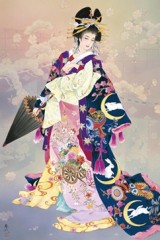 © Haruyo Moon and rabbit (Haruyo)A classic Haruyo design: a vividly decorated kimono, against a subdued, but patterned, background. The original title Tsuki-usagi simply concatenates the words for "moon" and "rabbit", and these are the most prominent emblems in the design. The connection may not be obvious, but in Japanese tradition, in place of a Man in the Moon, there is said to be a rabbit, beating glutinous rice... 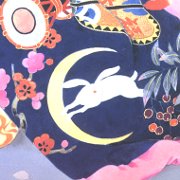 The artist Morita Haruyo studied both Japanese art and kimono design, and she combines these with elements of her own Western-influenced technique. (She travelled to London in 1977, exactly the year I [Brian Chandler] first came to Tokyo.) Morita is her family name: she follows the tradition of signing - and sealing - paintings with her given name only.  Permanently unavailable Permanently unavailableAn Epoch puzzle: 1000 pieces; 500 x 750 mm (20" x 30") Code: E11362 (11-362 on package) Retail price ¥3000 | ||
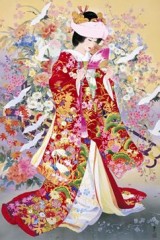 © Haruyo Yuiju (Haruyo)A bride, in an exceedingly ornate kimono decorated with flowers and cranes, while yet more cranes in the background promise good fortune. The title, Yuiju, is practically untranslatable: Yui is the "Bonds" of the series title, and ju is the character also read kotobuki and used only in a formulaic way, to mean "Good fortune" or "Congratulations." Perhaps this amounts to something like "Bridal fortune." The artist Morita Haruyo studied both Japanese art and kimono design, and she combines these with elements of her own Western-influenced technique. (She travelled to London in 1977, exactly the year I [Brian Chandler] first came to Tokyo.) Morita is her family name: she follows the tradition of signing - and sealing - paintings with her given name only.  Permanently unavailable Permanently unavailableDiscontinued November 2017 An Epoch puzzle: 1000 pieces; 500 x 750 mm (20" x 30") Code: E11416 (11-416 on package) Retail price ¥3000 | ||
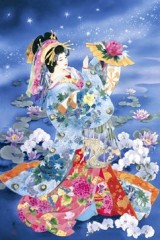 © Haruyo Starflower (Haruyo)A courtesan wears another of Haruyo's lavishly decorated kimonos, with a blue uchikake, or outer layer, providing space for more ornamentation with peacock feathers. The background lily pond merges into the starry sky above... This puzzle forms a pair with Moonflower (E11430): you can combine the two for a full-size 2000-piece puzzle. The artist Morita Haruyo studied both Japanese art and kimono design, and she combines these with elements of her own Western-influenced technique. (She travelled to London in 1977, exactly the year I [Brian Chandler] first came to Tokyo.) Morita is her family name: she follows the tradition of signing - and sealing - paintings with her given name only.  Permanently unavailable Permanently unavailableDiscontinued June 2017 An Epoch puzzle: 1000 pieces; 500 x 750 mm (20" x 30") Code: E11429 (11-429 on package) Retail price ¥3000 | ||
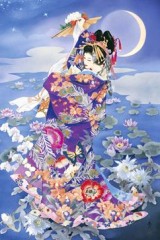 © Haruyo Moonflower (Haruyo)A courtesan shows off a lush purple kimono adorned with flowers, peacock feathers, and butterflies. Over the background lotus pond looms a huge crescent moon.. This puzzle forms a pair with Starflower (E11429): you can combine the two for a full-size 2000-piece puzzle. The artist Morita Haruyo studied both Japanese art and kimono design, and she combines these with elements of her own Western-influenced technique. (She travelled to London in 1977, exactly the year I [Brian Chandler] first came to Tokyo.) Morita is her family name: she follows the tradition of signing - and sealing - paintings with her given name only.  Permanently unavailable Permanently unavailableDiscontinued March 2018 An Epoch puzzle: 1000 pieces; 500 x 750 mm (20" x 30") Code: E11430 (11-430 on package) Retail price ¥3000 | ||
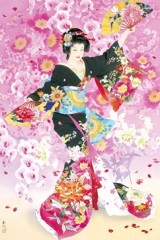 © Haruyo Dance of a hundred flowers (Haruyo)The flamboyant dancer wears a kimono black with ornate decoration, nicely setting off Haruyo's floral background. The artist Morita Haruyo studied both Japanese art and kimono design, and she combines these with elements of her own Western-influenced technique. (She travelled to London in 1977, exactly the year I [Brian Chandler] first came to Tokyo.) Morita is her family name: she follows the tradition of signing - and sealing - paintings with her given name only.  Permanently unavailable Permanently unavailableDiscontinued January 2023 An Epoch puzzle: 1000 pieces; 500 x 750 mm (20" x 30") Code: E11436 (11-436 on package) Retail price ¥3000 | ||
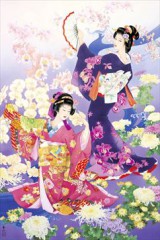 © Haruyo Orchid and chrysanthemum (Haruyo)The full title (which fits conveniently into four Chinese characters) is "Spring orchid autumn chrysanthemum", and the two figures nicely contrast, with a deep pink kimono for spring, and deep purple for autumn, in a typical Haruyo setting. The artist Morita Haruyo studied both Japanese art and kimono design, and she combines these with elements of her own Western-influenced technique. (She travelled to London in 1977, exactly the year I [Brian Chandler] first came to Tokyo.) Morita is her family name: she follows the tradition of signing - and sealing - paintings with her given name only.  Permanently unavailable Permanently unavailableDiscontinued March 2022 An Epoch puzzle: 1000 pieces; 500 x 750 mm (20" x 30") Code: E11445 (11-445 on package) Retail price ¥3000 | ||
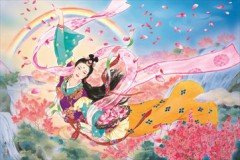 © Haruyo Peach blossom angel (Haruyo)Haruyo depicts this heavenly swirling figure with panache. With a name no doubt derived from the ancient Chinese legend of the the Peach Blossom Spring, this flying creature is more properly a tennyo, a kind of heavenly messenger whose origins are lost in the mists of India. Wikipedia articles on The Peach Blossom Spring and tennyo The artist Morita Haruyo studied both Japanese art and kimono design, and she combines these with elements of her own Western-influenced technique. (She travelled to London in 1977, exactly the year I [Brian Chandler] first came to Tokyo.) Morita is her family name: she follows the tradition of signing - and sealing - paintings with her given name only.  Permanently unavailable Permanently unavailableDiscontinued June 2018 An Epoch puzzle: 1000 pieces; 750 x 500 mm (30" x 20") Code: E11460 (11-460 on package) Retail price ¥3000 | ||
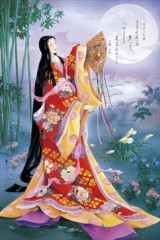 © Haruyo Dream poem (Haruyo)A beauty from the Heian period, a thousand years or so ago, has a pensive look under the full moon. Haruyo has added a poem by a famously beautiful poetess of the period, Ono no Komachi. (This is a waka, comprising 5-7-5-7-7 syllables.) Utsutsu ni wa / samo koso arame / yume ni sae / hitome wo moru to / miru ga wabishisa The artist Morita Haruyo studied both Japanese art and kimono design, and she combines these with elements of her own Western-influenced technique. (She travelled to London in 1977, exactly the year I [Brian Chandler] first came to Tokyo.) Morita is her family name: she follows the tradition of signing - and sealing - paintings with her given name only.  Permanently unavailable Permanently unavailableDiscontinued May 2019 An Epoch puzzle: 1000 pieces; 500 x 750 mm (20" x 30") Code: E11478 (11-478 on package) Retail price ¥3000 | ||
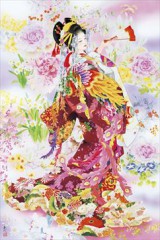 © Haruyo Enka (Haruyo)A very luxuriant feather kimono adorns this classic Haruyo beauty. (The title Enka combines the characters for "lustrous" and "floral".) The artist Morita Haruyo studied both Japanese art and kimono design, and she combines these with elements of her own Western-influenced technique. (She travelled to London in 1977, exactly the year I [Brian Chandler] first came to Tokyo.) Morita is her family name: she follows the tradition of signing - and sealing - paintings with her given name only.  Permanently unavailable Permanently unavailableDiscontinued May 2019 An Epoch puzzle: 1000 pieces; 500 x 750 mm (20" x 30") Code: E11501 (11-501 on package) Retail price ¥3000 | ||
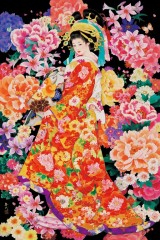 © Haruyo Stand like a peony (Haruyo)The title is part of an old saying, which describes the perfect female figure: "Stand like a shakuyaku, sit like a botan, and walk like a lily." This does not work very well in English, because the first two are both varieties of peony: shakuyaku is Paeonia lactiflora, or the common garden peony, and botan is Paeonia suffruticosa, or the Chinese tree peony. But Haruyo makes everything clear: not only with the floral kimono, but also by surrounding the figure with a mass of peony blooms. The artist Morita Haruyo studied both Japanese art and kimono design, and she combines these with elements of her own Western-influenced technique. (She travelled to London in 1977, exactly the year I [Brian Chandler] first came to Tokyo.) Morita is her family name: she follows the tradition of signing - and sealing - paintings with her given name only.  Permanently unavailable Permanently unavailableDiscontinued May 2020 An Epoch puzzle: 1000 pieces; 500 x 750 mm (20" x 30") Code: E11538 (11-538 on package) Retail price ¥3000 | ||
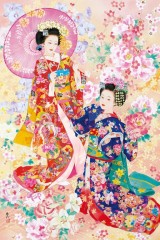 © Haruyo Kyoto maidens (Haruyo)Two young ladies, obviously of high class, one with a parasol gesturing elegantly, the other wrapping her arms in the long sleeves of her kimono in a way so familiar in an era long gone. The artist Morita Haruyo studied both Japanese art and kimono design, and she combines these with elements of her own Western-influenced technique. (She travelled to London in 1977, exactly the year I [Brian Chandler] first came to Tokyo.) Morita is her family name: she follows the tradition of signing - and sealing - paintings with her given name only.  Permanently unavailable Permanently unavailableDiscontinued March 2023 An Epoch puzzle: 1000 pieces; 500 x 750 mm (20" x 30") Code: E11553 (11-553 on package) Retail price ¥3000 | ||
 © Haruyo Breeze of love (Haruyo)A geisha figure dreams of a lover... Her kimono is elegant rather than ornate, but there is also plenty of background interest in this image. The artist Morita Haruyo studied both Japanese art and kimono design, and she combines these with elements of her own Western-influenced technique. (She travelled to London in 1977, exactly the year I [Brian Chandler] first came to Tokyo.) Morita is her family name: she follows the tradition of signing - and sealing - paintings with her given name only.  Permanently unavailable Permanently unavailableDiscontinued May 2019 An Epoch puzzle: 1000 pieces; 500 x 750 mm (20" x 30") Code: E11564 (11-564 on package) Retail price ¥3000 | ||
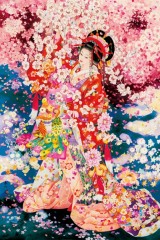 © Haruyo Cherry dream (Haruyo)Cherry blossom petals swirl around this courtesan, with her ostentatiously decorated kimono. A lot of pink in this puzzle! The artist Morita Haruyo studied both Japanese art and kimono design, and she combines these with elements of her own Western-influenced technique. (She travelled to London in 1977, exactly the year I [Brian Chandler] first came to Tokyo.) Morita is her family name: she follows the tradition of signing - and sealing - paintings with her given name only.  Permanently unavailable Permanently unavailableDiscontinued May 2019 An Epoch puzzle: 1000 pieces; 500 x 750 mm (20" x 30") Code: E11568 (11-568 on package) Retail price ¥3000 | ||
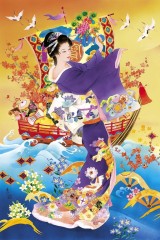 © Haruyo Dance of treasure (Haruyo)A courtesan in a gorgeous purple kimono dances, as the treasure boat sails by in the background, and an auspicious flock of cranes passes overhead. This puzzle forms a pair with the Dance of fortune (E11573): you can combine the two for a full-size 2000-piece puzzle. The artist Morita Haruyo studied both Japanese art and kimono design, and she combines these with elements of her own Western-influenced technique. (She travelled to London in 1977, exactly the year I [Brian Chandler] first came to Tokyo.) Morita is her family name: she follows the tradition of signing - and sealing - paintings with her given name only.  Permanently unavailable Permanently unavailableDiscontinued June 2024 An Epoch puzzle: 1000 pieces; 500 x 750 mm (20" x 30") Code: E11572 (11-572 on package) Retail price ¥3000 | ||
 © Haruyo Dance of fortune (Haruyo)This courtesan has a bright red kimono, with a design including the "treasure" character (宝). She dances in front of an elaborate traditional cart bearing a splendid array of flowers and foliage. A red Mount Fuji in the background completes the scene with over-flying cranes (actually heading into the matching puzzle "Dance of treasure"). This puzzle forms a pair with the Dance of treasure (E11572): you can combine the two for a full-size 2000-piece puzzle. The artist Morita Haruyo studied both Japanese art and kimono design, and she combines these with elements of her own Western-influenced technique. (She travelled to London in 1977, exactly the year I [Brian Chandler] first came to Tokyo.) Morita is her family name: she follows the tradition of signing - and sealing - paintings with her given name only.  Permanently unavailable Permanently unavailableDiscontinued February 2025 An Epoch puzzle: 1000 pieces; 500 x 750 mm (20" x 30") Code: E11573 (11-573 on package) Retail price ¥3000 | ||
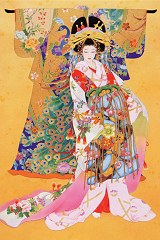 © Studio Morita / Studio Oz Inc Gold (Haruyo)The original title, Kogane Miyabi, says it all: "Golden elegance." The young model is ornately dressed in a silver and floral design kimono, but is still outdone by the backdrop - her outer robe of a golden peacock design. This puzzle is printed on a special foil surface. The artist Morita Haruyo studied both Japanese art and kimono design, and she combines these with elements of her own Western-influenced technique. (She travelled to London in 1977, exactly the year I [Brian Chandler] first came to Tokyo.) Morita is her family name: she follows the tradition of signing - and sealing - paintings with her given name only.
 Permanently unavailable Permanently unavailableAn Epoch puzzle: 1000 pieces; 500 x 750 mm (20" x 30") Code: E13235 (13-235 on package) Retail price ¥3900 | ||
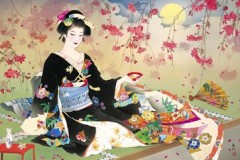 © Haruyo Evening cherry (Haruyo)A classic pose: a young woman sits gracefully in a vivid floral kimono, to a backdrop of cherry blossoms. You will need to look out for the "mistakes" in the picture on the box, but this should be a fun puzzle, with plenty of texture and no tedious uniform areas. The artist Morita Haruyo studied both Japanese art and kimono design, and she combines these with elements of her own Western-influenced technique. (She travelled to London in 1977, exactly the year I [Brian Chandler] first came to Tokyo.) Morita is her family name: she follows the tradition of signing - and sealing - paintings with her given name only.
 Permanently unavailable Permanently unavailableAn Epoch puzzle: 1000 pieces; 750 x 500 mm (30" x 20") Code: E59002 (59-002 on package) Retail price ¥3900 | ||
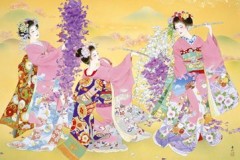 © Haruyo Kyoto dance (Haruyo)Three figures perform an elegant dance, with huge floral fronds (of wisteria?) — the original title is Kyo-no-mai. The artist Morita Haruyo studied both Japanese art and kimono design, and she combines these with elements of her own Western-influenced technique. (She travelled to London in 1977, exactly the year I [Brian Chandler] first came to Tokyo.) Morita is her family name: she follows the tradition of signing - and sealing - paintings with her given name only.
 Permanently unavailable Permanently unavailableAn Epoch puzzle: 1000 pieces; 750 x 500 mm (30" x 20") Code: E59008 (59-008 on package) Retail price ¥3900 | ||
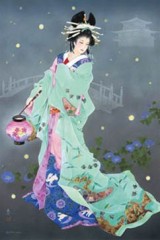 © Haruyo Firefly night (Haruyo)Fireflies (hotaru) are a classic symbol of summer. Here the figure, wearing a kimono elaborately decorated with rabbits and tropical fish, holds a lantern, perhaps to attract the fireflies, while in the shadowy background a traditional bridge and temple building can just be seen. The artist Morita Haruyo studied both Japanese art and kimono design, and she combines these with elements of her own Western-influenced technique. (She travelled to London in 1977, exactly the year I [Brian Chandler] first came to Tokyo.) Morita is her family name: she follows the tradition of signing - and sealing - paintings with her given name only.
 Permanently unavailable Permanently unavailableAn Epoch puzzle: 1000 pieces; 500 x 750 mm (20" x 30") Code: E59010 (59-010 on package) Retail price ¥3900 | ||
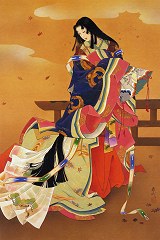 © Studio Morita / Studio Oz Inc Melancholy (Haruyo)The Tale of Genji (Genji monogatari) is said to be the world's first novel, written in around 1000 AD, by the Lady Murasaki Shikibu (978-1016). Haruyo has chosen vignettes from the story, to illustrate the opulent fashion of court life in the Heian era. Yûshû - melancholy. This is Murasaki, Genji's longest, truest love, it seems, reduced to desolation when Genji marries the Third Princess. Why, in an era when it was quite normal to marry several people? Well, though Genji remained emotionally faithful to Murasaki, she was far outranked in the complicated social scale by his new wife, and fell ill, never to recover. Notice how her hair is almost as long as the elaborate kimono she wears; apparently long hair was the principal thing men of the time were attracted by. 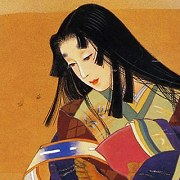 The artist Morita Haruyo studied both Japanese art and kimono design, and she combines these with elements of her own Western-influenced technique. (She travelled to London in 1977, exactly the year I [Brian Chandler] first came to Tokyo.) Morita is her family name: she follows the tradition of signing - and sealing - paintings with her given name only.  Permanently unavailable Permanently unavailableAn Epoch puzzle: 1000 pieces; 500 x 750 mm (20" x 30") Code: E83143 (1000SN-143 on package) Retail price ¥3000 | ||
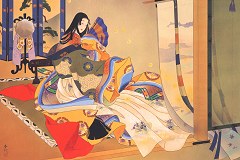 © Studio Morita / Studio Oz Inc Firefly (Haruyo)The Tale of Genji (Genji monogatari) is said to be the world's first novel, written in around 1000 AD, by the Lady Murasaki Shikibu (978-1016). Haruyo has chosen vignettes from the story, to illustrate the opulent fashion of court life in the Heian era. Koihotaru is the original title - simply "fireflies of love". In this episode of the story, Genji's foster daughter, Tamakazura, is having emotional problems with her suitors, and when visited at night by one of them, Prince Hotaru ("the Firefly Prince"), Genji helps things along by releasing a cloud of fireflies by whose glow her true beauty is revealed. 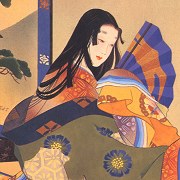 The artist Morita Haruyo studied both Japanese art and kimono design, and she combines these with elements of her own Western-influenced technique. (She travelled to London in 1977, exactly the year I [Brian Chandler] first came to Tokyo.) Morita is her family name: she follows the tradition of signing - and sealing - paintings with her given name only.  Permanently unavailable Permanently unavailableAn Epoch puzzle: 1000 pieces; 750 x 500 mm (30" x 20") Code: E83144 (1000SN-144 on package) Retail price ¥3000 | ||
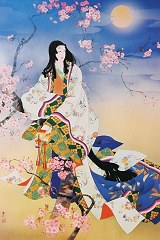 © Studio Morita / Studio Oz Inc Charm (Haruyo)The Tale of Genji (Genji monogatari) is said to be the world's first novel, written in around 1000 AD, by the Lady Murasaki Shikibu (978-1016). Haruyo has chosen vignettes from the story, to illustrate the opulent fashion of court life in the Heian era. The original title on the box is Yûen, a poetic term for grace and beauty. This lady is one of Genji's many lovers, but is also (unknown to Genji) the daughter of an enemy. Here she awaits a tryst in her many-layered kimono, under the hazy spring moon (oborozuki: another icon of Japanese literature). 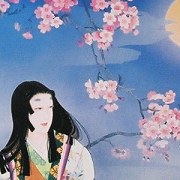 The artist Morita Haruyo studied both Japanese art and kimono design, and she combines these with elements of her own Western-influenced technique. (She travelled to London in 1977, exactly the year I [Brian Chandler] first came to Tokyo.) Morita is her family name: she follows the tradition of signing - and sealing - paintings with her given name only.  Permanently unavailable Permanently unavailableAn Epoch puzzle: 1000 pieces; 500 x 750 mm (20" x 30") Code: E83170 (1000SN-170 on package) Retail price ¥3000 | ||
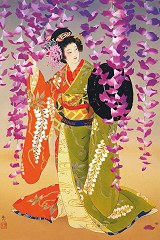 © Studio Morita / Studio Oz Inc Fujimusume (Haruyo)Fujimusume is a traditional character from Japanese dance - her name comes from fuji, wisteria (nothing to do with Mt. Fuji) and musume, means "daughter" or simply "young woman". Typically she dances on a stage set with exuberantly stylised hanging blossom. The wide black hat is another standard accessory: perhaps Haruyo's character holds it in her hand to give us a better view of the decorations in her hair. 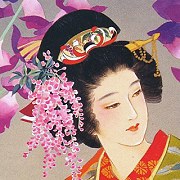 Kaname's version of Fujimusume (1000 pieces) The artist Morita Haruyo studied both Japanese art and kimono design, and she combines these with elements of her own Western-influenced technique. (She travelled to London in 1977, exactly the year I [Brian Chandler] first came to Tokyo.) Morita is her family name: she follows the tradition of signing - and sealing - paintings with her given name only.  Permanently unavailable Permanently unavailableAn Epoch puzzle: 1000 pieces; 500 x 750 mm (20" x 30") Code: E83171 (1000SN-171 on package) Retail price ¥3000 | ||
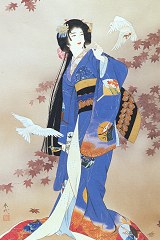 © Studio Morita / Studio Oz Inc Sachi (Haruyo)The title, Sachi, means "happiness" or "blessings". There is a simple, classical elegance to this portrait of a lady with two doves. There's a bonus with this puzzle: on the back of the box appears the whole range of Haruyo puzzles as of around the year 2000 - unfortunately only a very few of these are still available. 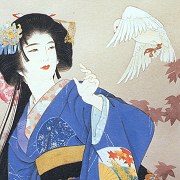 The artist Morita Haruyo studied both Japanese art and kimono design, and she combines these with elements of her own Western-influenced technique. (She travelled to London in 1977, exactly the year I [Brian Chandler] first came to Tokyo.) Morita is her family name: she follows the tradition of signing - and sealing - paintings with her given name only.  Permanently unavailable Permanently unavailableAn Epoch puzzle: 1000 pieces; 500 x 750 mm (20" x 30") Code: E83213 (1000SN-213F on package) Retail price ¥3000 | ||
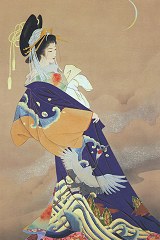 © Studio Morita / Studio Oz Inc Oborozuki (Haruyo)The title is somewhat difficult to translate: "the (spring) moon, shrouded in haze," a common motif in both art and song. Haruyo has placed the moon right at the top right corner, and given her model a striking diagonal pose. (Incidentally leaving quite a large plain area for a puzzle!) Although the colours here are restrained, the courtesan holds her outer robe to give us a good view of the picture on it - a crane, over woods and waves. 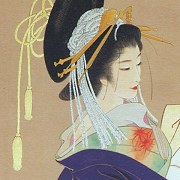 There's a bonus with this puzzle: on the back of the box appears the whole range of Haruyo puzzles as of around the year 2000 - unfortunately only a very few of these are still available. The artist Morita Haruyo studied both Japanese art and kimono design, and she combines these with elements of her own Western-influenced technique. (She travelled to London in 1977, exactly the year I [Brian Chandler] first came to Tokyo.) Morita is her family name: she follows the tradition of signing - and sealing - paintings with her given name only.  Permanently unavailable Permanently unavailableAn Epoch puzzle: 1000 pieces; 500 x 750 mm (20" x 30") Code: E83214 (1000SN-214F on package) Retail price ¥3000 |
500 pieces
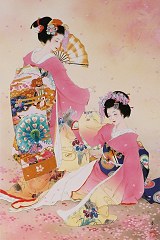 © Studio Morita / Studio Oz Inc Two ladies (Haruyo)The original title, Futarimai, literally means "a dance of two people" and the two figures are posed as if in a swirl of fallen cherry blossom. Remember that traditionally the feature of a kimono regarded as sexiest was the revealed back of the neck. The artist Morita Haruyo studied both Japanese art and kimono design, and she combines these with elements of her own Western-influenced technique. (She travelled to London in 1977, exactly the year I [Brian Chandler] first came to Tokyo.) Morita is her family name: she follows the tradition of signing - and sealing - paintings with her given name only.  Permanently unavailable Permanently unavailableAn Epoch puzzle: 500 pieces; 380 x 530 mm (15" x 21") Code: E06024 (06-024S on package) Retail price ¥2000 |
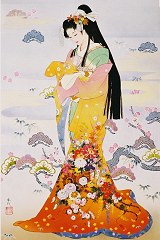 © Studio Morita / Studio Oz Inc Floral (Haruyo)A somewhat pensive lady displays this sumptuously florid kimono. The background gives a semi-abstract impression of clouds and plants, simultaneously reflecting the artist's enthusiasm for textile design. Original title: Shôka ("Syoka" on the box) The artist Morita Haruyo studied both Japanese art and kimono design, and she combines these with elements of her own Western-influenced technique. (She travelled to London in 1977, exactly the year I [Brian Chandler] first came to Tokyo.) Morita is her family name: she follows the tradition of signing - and sealing - paintings with her given name only.  Permanently unavailable Permanently unavailableAn Epoch puzzle: 500 pieces; 380 x 530 mm (15" x 21") Code: E06025 (06-025S on package) Retail price ¥2000 |
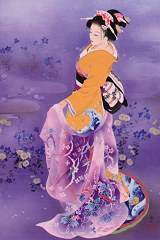 © Studio Morita / Studio Oz Inc Violet (Haruyo)A delicate young model holds a gauzy purple veil, and just reveals on her sleeve an echo of Hokusai's "Wave." Original title: Shiyu The artist Morita Haruyo studied both Japanese art and kimono design, and she combines these with elements of her own Western-influenced technique. (She travelled to London in 1977, exactly the year I [Brian Chandler] first came to Tokyo.) Morita is her family name: she follows the tradition of signing - and sealing - paintings with her given name only.  Permanently unavailable Permanently unavailableAn Epoch puzzle: 500 pieces; 380 x 530 mm (15" x 21") Code: E06032 (06-032S on package) Retail price ¥2000 |
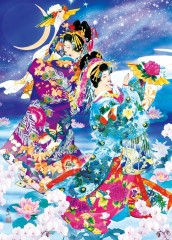 © Haruyo Starflower moonflower (Haruyo)This is a synthesis of the figures from the separate Starflower and Moonflower puzzles, making an interesting composition for a 500-piece puzzle. The artist Morita Haruyo studied both Japanese art and kimono design, and she combines these with elements of her own Western-influenced technique. (She travelled to London in 1977, exactly the year I [Brian Chandler] first came to Tokyo.) Morita is her family name: she follows the tradition of signing - and sealing - paintings with her given name only.  Permanently unavailable Permanently unavailableDiscontinued July 2019 An Epoch puzzle: 500 pieces; 380 x 530 mm (15" x 21") Code: E06051 (06-051 on package) Retail price ¥2000 |
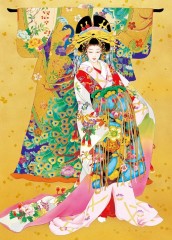 © Haruyo Gold (Haruyo)The original title, Kogane Miyabi, says it all: "Golden elegance." The young model is ornately dressed in a silver and floral design kimono, but is still outdone by the backdrop — her outer robe of a golden peacock design. 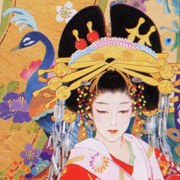 The artist Morita Haruyo studied both Japanese art and kimono design, and she combines these with elements of her own Western-influenced technique. (She travelled to London in 1977, exactly the year I [Brian Chandler] first came to Tokyo.) Morita is her family name: she follows the tradition of signing - and sealing - paintings with her given name only.  Permanently unavailable Permanently unavailableDiscontinued July 2019 An Epoch puzzle: 500 pieces; 380 x 530 mm (15" x 21") Code: E06069 (06-069 on package) Retail price ¥2000 |
450 pieces
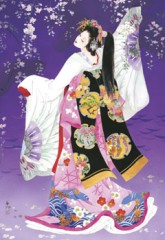 © Studio Morita / Studio Oz Inc Spirit of the heron (Haruyo)This dance is a classic kabuki number, entitled sagi-musume or the Heron-girl, in which the single dancer portrays the agony of love, through all its phases. By folding or unfolding parts of her costume, she can completely change her appearance. This is another chance for Haruyo to show us richly varied kimono layers, which she has set against a luxuriant purple backdrop. The artist Morita Haruyo studied both Japanese art and kimono design, and she combines these with elements of her own Western-influenced technique. (She travelled to London in 1977, exactly the year I [Brian Chandler] first came to Tokyo.) Morita is her family name: she follows the tradition of signing - and sealing - paintings with her given name only.
 Permanently unavailable Permanently unavailableAn Epoch puzzle: 450 pieces; 260 x 380 mm (10" x 15") Code: E08010 (08-010 on package) Retail price ¥1400 |
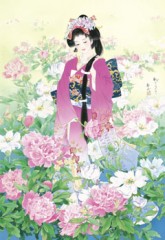 © Studio Morita / Studio Oz Inc Peony (Haruyo)Holding a peony in her hand, the young figure in this picture (the hairstyle shows her to be a princess) is surrounded by a veritable forest of blooms. Haruyo stresses the innocence of her pose with the subtitle "Shyly..." (by the signature). The artist Morita Haruyo studied both Japanese art and kimono design, and she combines these with elements of her own Western-influenced technique. (She travelled to London in 1977, exactly the year I [Brian Chandler] first came to Tokyo.) Morita is her family name: she follows the tradition of signing - and sealing - paintings with her given name only.
 Permanently unavailable Permanently unavailableAn Epoch puzzle: 450 pieces; 260 x 380 mm (10" x 15") Code: E08011 (08-011 on package) Retail price ¥1400 |
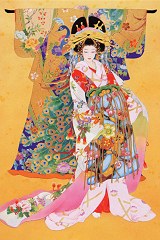 © Studio Morita / Studio Oz Inc Gold (Haruyo)The original title, Kogane Miyabi, says it all: "Golden elegance." The young model is ornately dressed in a silver and floral design kimono, but is still outdone by the backdrop - her outer robe of a golden peacock design. 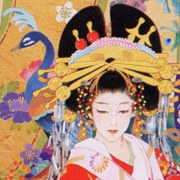 The artist Morita Haruyo studied both Japanese art and kimono design, and she combines these with elements of her own Western-influenced technique. (She travelled to London in 1977, exactly the year I [Brian Chandler] first came to Tokyo.) Morita is her family name: she follows the tradition of signing - and sealing - paintings with her given name only.
 Permanently unavailable Permanently unavailableAn Epoch puzzle: 450 pieces; 260 x 380 mm (10" x 15") Code: E08012 (08-012 on package) Retail price ¥1400 |
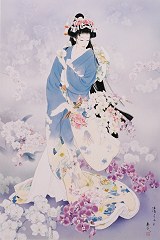 © Studio Morita / Studio Oz Inc Orchid (Haruyo)More precisely Phalaenopsis or the moth orchid - the young lady in this picture is surrounded by these exquisite and exotic blooms. It is difficult for the Web version to do justice to the delicate beauty of this image. The original title, Kochouran is literally "moth orchid". (Incidentally, these are said to be relatively easy orchids to grow yourself!) 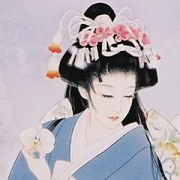 The artist Morita Haruyo studied both Japanese art and kimono design, and she combines these with elements of her own Western-influenced technique. (She travelled to London in 1977, exactly the year I [Brian Chandler] first came to Tokyo.) Morita is her family name: she follows the tradition of signing - and sealing - paintings with her given name only.
 Permanently unavailable Permanently unavailableAn Epoch puzzle: 450 pieces; 260 x 380 mm (10" x 15") Code: E08013 (08-013 on package) Retail price ¥1400 |
 © Haruyo Lustrous white (Haruyo)This young bride has a modest enough pose, but her wedding kimono is luxuriant - diaphanous, a tinge of pale green, with a pattern of white cranes. Over the plum blossoms in the background, a pair of golden cranes bring good fortune. Original title: Kihaku. Note: The colours in this image are very delicate, and the original printed version looks much better than an image on the screen! The artist Morita Haruyo studied both Japanese art and kimono design, and she combines these with elements of her own Western-influenced technique. (She travelled to London in 1977, exactly the year I [Brian Chandler] first came to Tokyo.) Morita is her family name: she follows the tradition of signing - and sealing - paintings with her given name only.
 Permanently unavailable Permanently unavailableDiscontinued March 2019 An Epoch puzzle: 450 pieces; 260 x 380 mm (10" x 15") Code: E08042 (08-042 on package) Retail price ¥1400 |
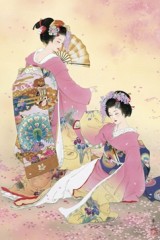 © Haruyo Double dance (Haruyo)Two elegant dancer are posed as if in a swirl of fallen cherry blossom, and the standing figure reminds us that traditionally the feature of a kimono regarded as sexiest was the revealed back of the neck. Original title: Futarimai (the earlier 1000-piece version we titled Two ladies) The artist Morita Haruyo studied both Japanese art and kimono design, and she combines these with elements of her own Western-influenced technique. (She travelled to London in 1977, exactly the year I [Brian Chandler] first came to Tokyo.) Morita is her family name: she follows the tradition of signing - and sealing - paintings with her given name only.
 Permanently unavailable Permanently unavailableAn Epoch puzzle: 450 pieces; 260 x 380 mm (10" x 15") Code: E08043 (08-043 on package) Retail price ¥1400 |
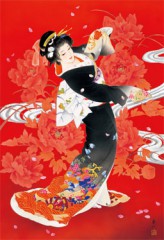 © Haruyo Scarlet (Haruyo)A classic geisha pose - the model playfully shows off the ornate furisode sleeves of her kimono, against the background of a sumptuous red peony design. The original title, hien, is a rather fanciful word that might be translated "voluptuous scarlet." The artist Morita Haruyo studied both Japanese art and kimono design, and she combines these with elements of her own Western-influenced technique. (She travelled to London in 1977, exactly the year I [Brian Chandler] first came to Tokyo.) Morita is her family name: she follows the tradition of signing - and sealing - paintings with her given name only.
 Permanently unavailable Permanently unavailableDiscontinued January 2017 An Apollo puzzle: 450 pieces; 260 x 380 mm (10" x 15") Code: P44504 (44-504 on package) Retail price ¥1800 |
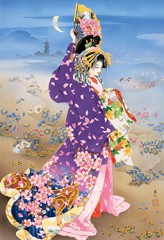 © Haruyo Evening mist (Haruyo)A courtesan, with front-tied obi and sumptuous purple kimono, strikes a dramatic pose - her camellia-patterned fan above her head as though to beckon the misty moon. The artist Morita Haruyo studied both Japanese art and kimono design, and she combines these with elements of her own Western-influenced technique. (She travelled to London in 1977, exactly the year I [Brian Chandler] first came to Tokyo.) Morita is her family name: she follows the tradition of signing - and sealing - paintings with her given name only.
 Permanently unavailable Permanently unavailableAn Apollo puzzle: 450 pieces; 260 x 380 mm (10" x 15") Code: P44710 (44-710 on package) Retail price ¥2000 |
420 pieces
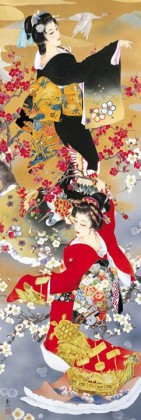 © Haruyo Crane and turtle (Haruyo)This "scroll" puzzle combines the separate "crane" and "turtle" figures in this series with a background of plum blossoms. The crane and turtle are both traditional auspicious symbols of happiness and longevity. It is said that if a crane lives to be 1000, a turtle lives to be 10,000. The artist Morita Haruyo studied both Japanese art and kimono design, and she combines these with elements of her own Western-influenced technique. (She travelled to London in 1977, exactly the year I [Brian Chandler] first came to Tokyo.) Morita is her family name: she follows the tradition of signing - and sealing - paintings with her given name only.
 Permanently unavailable Permanently unavailableDiscontinued July 2020 An Epoch puzzle: 420 pieces; 182 x 515 mm (7" x 20") Code: E52130 (52-130 on package) Retail price ¥1800 |
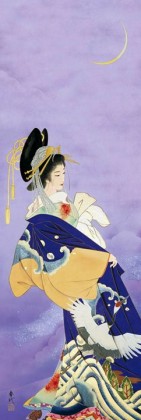 © Haruyo Oborozuki (Haruyo)The title is somewhat difficult to translate: "the (spring) moon, shrouded in haze," a common motif in both art and song. Haruyo has placed the moon right at the top right corner, and given her model a striking diagonal pose. (Incidentally leaving quite a large plain area for a puzzle!) Although the colours here are restrained, the courtesan holds her outer robe to give us a good view of the picture on it - a crane, over woods and waves. This is a new, "scroll" version of a puzzle from many years back, so the "blank area" has moved to the top. The artist Morita Haruyo studied both Japanese art and kimono design, and she combines these with elements of her own Western-influenced technique. (She travelled to London in 1977, exactly the year I [Brian Chandler] first came to Tokyo.) Morita is her family name: she follows the tradition of signing - and sealing - paintings with her given name only.
 Permanently unavailable Permanently unavailableDiscontinued July 2020 An Epoch puzzle: 420 pieces; 182 x 515 mm (7" x 20") Code: E52131 (52-131 on package) Retail price ¥1800 |
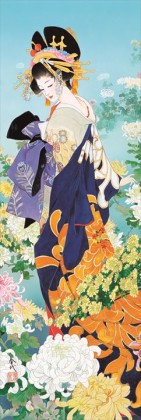 © Haruyo Chrysanthemum moon (Haruyo)This is a cropped version of the original "Chrysanthemum" in this series, portraying a courtesan in a kimono of deep blue and gold, with an obi of purple, decorated with peacock feathers. The original version includes a comment by Haruyo, "With noble heart..." — a fitting phrase, remembering that the chrysanthemum is the symbol of the Japanese Imperial crown. The artist Morita Haruyo studied both Japanese art and kimono design, and she combines these with elements of her own Western-influenced technique. (She travelled to London in 1977, exactly the year I [Brian Chandler] first came to Tokyo.) Morita is her family name: she follows the tradition of signing - and sealing - paintings with her given name only.
 Permanently unavailable Permanently unavailableAn Epoch puzzle: 420 pieces; 182 x 515 mm (7" x 20") Code: E52152 (52-152 on package) Retail price ¥1800 |
300 pieces
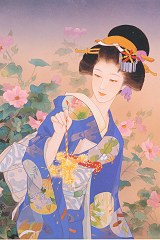 © Studio Morita / Studio Oz Inc Sparkler (Haruyo)The Tale of Genji (Genji monogatari) is said to be the world's first novel, written in around 1000 AD, by the Lady Murasaki Shikibu (978-1016). Haruyo has chosen vignettes from the story, to illustrate the opulent fashion of court life in the Heian era. The wearer of this kimono is holding a senkô hanabi, a firework that makes up for its lack of power with an exquisite delicacy. From the dangling, glowing blob, delicate sparks fly like filligree fronds. The original title, Ryô, means simply "cool" - for anyone who comes from England as I do, it helps to remember that in Japan fireworks mean summer, since there are no long light evenings to get in the way. 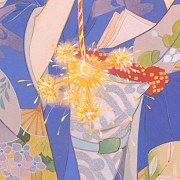 The artist Morita Haruyo studied both Japanese art and kimono design, and she combines these with elements of her own Western-influenced technique. (She travelled to London in 1977, exactly the year I [Brian Chandler] first came to Tokyo.) Morita is her family name: she follows the tradition of signing - and sealing - paintings with her given name only.  Permanently unavailable Permanently unavailableAn Epoch puzzle: 300 pieces; 260 x 380 mm (10" x 15") Code: E07429 (300N-429 on package) Retail price ¥1800 |
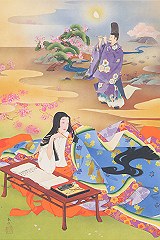 © Studio Morita / Studio Oz Inc Dream of Genji (Haruyo)The Tale of Genji (Genji monogatari) is said to be the world's first novel, written in around 1000 AD, by the Lady Murasaki Shikibu (978-1016). Haruyo has chosen vignettes from the story, to illustrate the opulent fashion of court life in the Heian era. Here we see the author herself, Murasaki Shikibu. As she ponders what to write, her hero Genji plays the flute, perhaps for a lover. Of course all this is an excuse for Haruyo's kimono imagination. Original title: Yume-maboroshi (dream-visions) 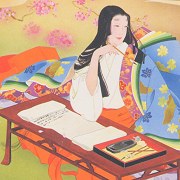 From the Tale of Genji site: a statue of the author at her writing table The artist Morita Haruyo studied both Japanese art and kimono design, and she combines these with elements of her own Western-influenced technique. (She travelled to London in 1977, exactly the year I [Brian Chandler] first came to Tokyo.) Morita is her family name: she follows the tradition of signing - and sealing - paintings with her given name only.  Permanently unavailable Permanently unavailableAn Epoch puzzle: 300 pieces; 260 x 380 mm (10" x 15") Code: E27019 (27-019 on package) Retail price ¥1500 |
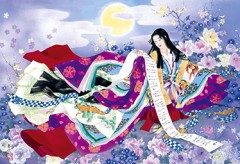 © Haruyo Dream purple (Haruyo)We instantly realise from the ankle-length hair that this character is from the Heian period, a thousand years ago, and an era of cultural flowering and incredibly ornate costumes. She reads a long, long letter, probably in the form of a poem, perhaps from a distant lover. The artist Morita Haruyo studied both Japanese art and kimono design, and she combines these with elements of her own Western-influenced technique. (She travelled to London in 1977, exactly the year I [Brian Chandler] first came to Tokyo.) Morita is her family name: she follows the tradition of signing - and sealing - paintings with her given name only.  Permanently unavailable Permanently unavailableDiscontinued June 2020 An Apollo puzzle: 300 pieces; 380 x 260 mm (15" x 10") Code: P48746 (48-746 on package) Retail price ¥1400 |
216 pieces
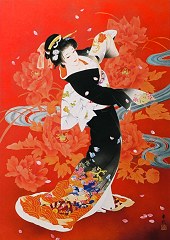 © Studio Morita / Studio Oz Inc Scarlet (Haruyo)A classic geisha pose - the model playfully shows off the ornate furisode sleeves of her kimono, against the background of a sumptuous red peony design. The original title, hien, is a rather fanciful word that might be translated "voluptuous scarlet." 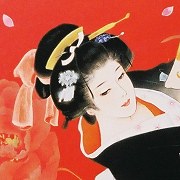 The artist Morita Haruyo studied both Japanese art and kimono design, and she combines these with elements of her own Western-influenced technique. (She travelled to London in 1977, exactly the year I [Brian Chandler] first came to Tokyo.) Morita is her family name: she follows the tradition of signing - and sealing - paintings with her given name only.
 Permanently unavailable Permanently unavailableAn Epoch puzzle: 216 pieces; 182 x 257 mm (7" x 10") Code: E04001 (04-001 on package) Retail price ¥1200 |
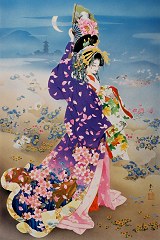 © Studio Morita / Studio Oz Inc Evening mist (Haruyo)A courtesan, with front-tied obi and sumptuous purple kimono, strikes a dramatic pose - her camellia-patterned fan above her head as though to beckon the misty moon.  The artist Morita Haruyo studied both Japanese art and kimono design, and she combines these with elements of her own Western-influenced technique. (She travelled to London in 1977, exactly the year I [Brian Chandler] first came to Tokyo.) Morita is her family name: she follows the tradition of signing - and sealing - paintings with her given name only.
 Permanently unavailable Permanently unavailableAn Epoch puzzle: 216 pieces; 182 x 257 mm (7" x 10") Code: E04002 (04-002 on package) Retail price ¥1200 |
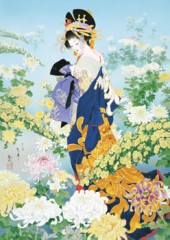 © Studio Morita / Studio Oz Inc Chrysanthemum (Haruyo)By her signature and seal, Haruyo has written "With noble heart..." - a fitting phrase, remembering that the chrysanthemum is the symbol of the Japanese Imperial crown. The courtesan wears a kimono of deep blue and gold, with an obi of purple, decorated with peacock feathers. The artist Morita Haruyo studied both Japanese art and kimono design, and she combines these with elements of her own Western-influenced technique. (She travelled to London in 1977, exactly the year I [Brian Chandler] first came to Tokyo.) Morita is her family name: she follows the tradition of signing - and sealing - paintings with her given name only.
 Permanently unavailable Permanently unavailableAn Epoch puzzle: 216 pieces; 182 x 257 mm (7" x 10") Code: E04009 (04-009 on package) Retail price ¥1200 |
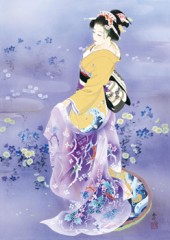 © Studio Morita / Studio Oz Inc Violet (Haruyo)A delicate young model holds a gauzy purple veil, and just reveals on her sleeve an echo of Hokusai's "Wave." Original title: Shiyu The artist Morita Haruyo studied both Japanese art and kimono design, and she combines these with elements of her own Western-influenced technique. (She travelled to London in 1977, exactly the year I [Brian Chandler] first came to Tokyo.) Morita is her family name: she follows the tradition of signing - and sealing - paintings with her given name only.
 Permanently unavailable Permanently unavailableAn Epoch puzzle: 216 pieces; 182 x 257 mm (7" x 10") Code: E04013 (04-013 on package) Retail price ¥1200 |
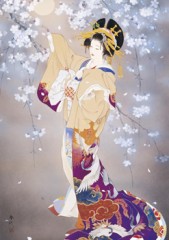 Evening (Haruyo)The wearer of this luxurious kimono - with a crane motif - has the obi (sash) tied at the front, a sign that she is a courtesan. Under thin moonlight filtering through the cherry blossoms, she has playfully wrapped the long sleeves around her hands. Original title: Yoi The artist Morita Haruyo studied both Japanese art and kimono design, and she combines these with elements of her own Western-influenced technique. (She travelled to London in 1977, exactly the year I [Brian Chandler] first came to Tokyo.) Morita is her family name: she follows the tradition of signing - and sealing - paintings with her given name only.
 Permanently unavailable Permanently unavailableAn Epoch puzzle: 216 pieces; 182 x 257 mm (7" x 10") Code: E04014 (04-014 on package) Retail price ¥1200 |
- 105 puzzles shown
- Explore the attics: complete list of deleted puzzles
Substituted puzzle
E20090: this puzzle reissued as E20109 - Evening (2000pcs)

 This puzzle has smaller pieces than the standard size.
This puzzle has smaller pieces than the standard size.